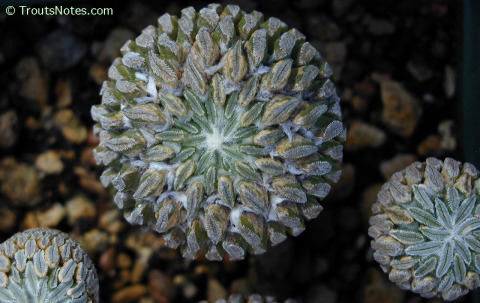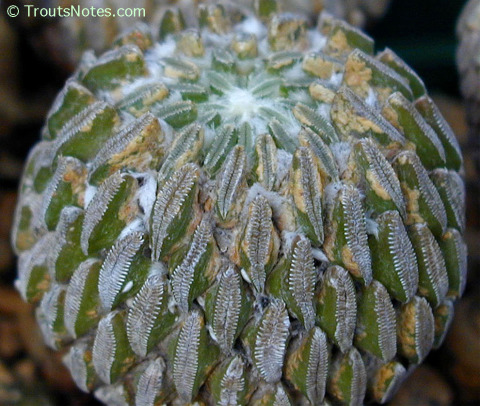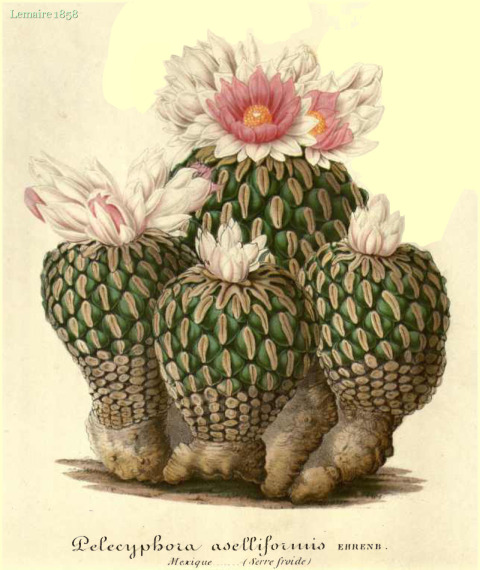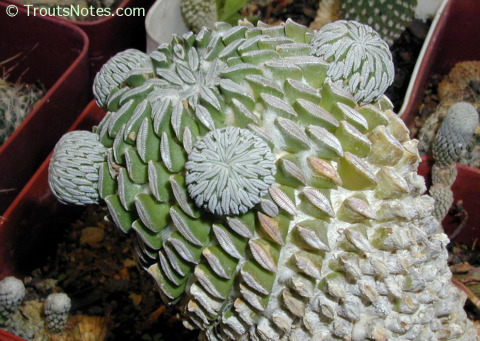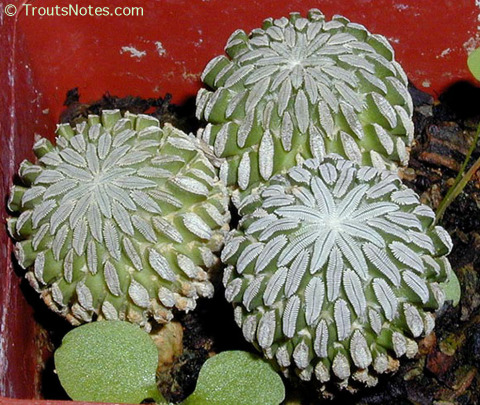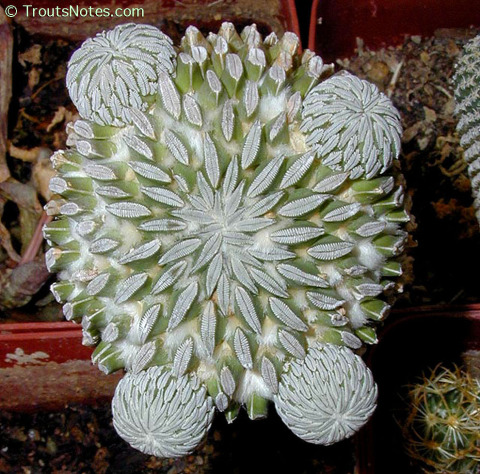Pelecyphora aselliformis Ehrenberg
Carl Ehrenberg (1843) Botanische Zeitung, 1: 737-738.
Mescaline reported in trace amounts.
Water content: 62% by weight.
Etymology: Pelecyphora is from the Greek; pelekys “axe” or “hatchet” and phoreo “I carry”:
Common names: “Hatchet cactus”, “Peote”, “Peotillo”, “Peyote meco”, “Peyote”, “Peyotillo”, “Peyotl” and “Piote”.
Distribution & occurrence: It is native to San Luis Potosí in Mexico.
Original description: “Stamm einzeln und mehrköpfig, plattkuglig, eingedrückt, birneförmig. Die einzeluen Pflanzen haben ¼ bis 2 Zoll Durchmesser und sind ½ bis 2 Zoll hoch. Oberfläche mit beilförmigen oben an der Schneide angestutzten, flachen, kammartig feingezähnten Höckern, spiralförmig besetzt. […]
Höcker beilförmig, graugrün, glatt, an der Basis etwas in die Breite gezogen, fast vierseitig, nach oben, vorn und am meisten nach hinten schmal zesammengedrückt, die schmalen Kanten nach unten zu abgerundet, die vordere nach dem Scheitel zu schnabelförmig erhöhlt, etwas übergebogen, die hintere abgerundet, oben an der Schniede angestutzt, schmal, in der Mitte etwas breiter, nach hinten spitz; auch länglich oval oder oval, etwas gewölbt oder wellenförmig (sattelförmig) ausgeschweift, vorn höher wie hinten, mit einem hornartigen graden oder gebogenen, flachen, abgerundeten oder in der Mitte kahnartig vertieften Schildchen (keilförmig in die Höcker eingewachsen), welches mit 2 Reihen horizontaler, bis fast an den Rand angewachsener, dann überstehender, durch bedeckt ist. In jeder Reihe sind circa 25, zusammen circa 50 Zähnchen befindlich. Achseln und Seitenwände der Höcher am Scheitel und der Scheitel selbst mit feiner seidenartiger Wolle besetzt, welche länger ist als die Höcker, sich aber umlegt. Blüthen achselständig mit seidenartiger Wolle umgeben, das Nähere unbekannt. Beeren länglich, oben spitz, Saamen nierenförmig. (Baebachtung von 1839). Jetzt zeigen sich an den lebenden Pflanzen die Früchte in der obern Achsel der Höcker, in Form dünnhäutiger Beeren mit weingen nierenförmigem Saamen (von der Grösse wie bei den krausrippigen Echinocacten oder eines mässigen Stecknadelknopfes). Diese Beere ist aber fest in das Fleisch, in den Stamm eingewachsen und scheint sich nicht bei der Reife herauszuheben, wie bei den Mammillarien und andern Cacteen. Die Saamen aber erscheinen einzeln aus den geplatzten Beeren an der Oberfläche zwischen den Kämmchen in der Seide.
Höcker 1–4 Linien hoch, 1–4 L. lang, unten 2 L. breit, oben 1–12 L. breit. Vaterland Mexico.” columns 737–738 in Ehrenberg 1843.
These small plants are round in cross-section and somewhat club shaped. Their tops are slightly flattened and they tend to grow almost flush with the ground in the wild similar to peyote. (In cultivation the stems are usually exposed.)
They grow to 10 cm tall and 5.5 cm wide with age.
Tubercles are up to 5 mm tall and set in spirals on the body.
The long areoles have spines which are united with each other forming a peculiar shape which gives them the name of ‘hatchet cactus’ in reference to the shape of the tubercles.
The spines are very small, the longest being in the center of the tubercle.
The root is thick and fleshy.
Carmine-violet flowers are bell-shaped to funnel-form and can reach more than 3 cm in diameter. Pizzetti describes the petals as crimson-violet and the sepals as white.
Backeberg 1977: 408 and personal observations.
See also Backeberg 1961: 3077-3082, (includes pictures, one as close-up) and Britton & Rose 1923: 59-60 (picture page 58, fig. 56. Schuster 1990 has a picture with flower, on page 188.
Photo on page 103 of Anderson 1998.
Pizzetti 1985: Entry #257 with picture.
Sold in the drug markets of San Luís Potosí for fevers (citing Safford 1909). Also used locally north of there for rheumatic pains. Bruhn & Bruhn 1973
Reported analysis:
The presence of anhalidine and hordenine was reported in Agurell et al. 1971b.
Neal et al. 1972 isolated and reported identifying N,N-dimethyl-3-hydroxy-4,5-dimethoxyphenethylamine (AKA 3-demethyltrichocereine) and pellotine using wild-collected plants.
Bruhn & Bruhn found N,N-dimethyl-3-hydroxy-4,5-dimethoxyphenethylamine was the major alkaloid in their specimens and also observed hordenine and pellotine in the phenolic fraction (also using wild-collected plants).
In the nonphenolic fraction, Neal et al. 1972 had additionally identified trace amounts of mescaline, N-methylmescaline, 3,4-dimethoxyphenethylamine and N-methyl-3,4-dimethoxy-phenethylamine.
Bruhn & Bruhn were unable to confirm the presence of the aforementioned trace components in the nonphenolic fraction due to the presence of a larger amount of an unidentified nonphenolic alkaloid or alkaloids. Bruhn & Bruhn 1973
Mescaline was reported at 0.003% by Siniscalco Gigliano 1983 (using plants cultivated in Italy).
Agurell reported this species to contain 1-10 mg. / 100 grams of total alkaloid in the fresh plant (using gc-ms) using material cultivated in Europe:
Anhalidine as 10-50% of the total alkaloid
Hordenine as 10-50% of the total alkaloid
Unknown as 10-50% of the total alkaloid
Unknown as traces
Agurell et al. 1971b (Mescaline was not observed by Agurell.)
Preparative TLC was used by Neal to separate the alkaloids using Chloroform-Ethanol-Ammonium hydroxide (15:20:1) as the developing solution. They were unable to separate mescaline from 3,4-Dimethoxy-phenethylamine (the same was true with their N-methyl analogs) by the use of tlc and successfully used gc for the separation.
They used ms of the dansyl derivatives for identification.
5.5 kg. of dried cactus [300 plants] were extracted to recover a total of:
Hordenine (Major alkaloid at 0.00063%; recovering 34.7 mg as the hydrochloride.) [Identification by mp, mmp, tlc, IR]
Anhalidine (0.000067%; recovering 3.7 mg as the hydrochloride.) [mp, mmp, tlc, IR]
Pellotine (0.0000094%; recovering 0.52 mg as the hydrochloride.) [mp, mmp, tlc, ms]
Mescaline (less than 0.00002% determined by GLC; they were unable to purify with tlc but this equates to a concentration of less than 1.1 mg per 5.5 kg [i.e. less than 200 μg per kg of dried plants].) [glc, ms]
[The figure 0.0002%, appearing in the literature, is in error]
N-Methylmescaline (trace amount; % not given.) [glc, ms]
3,4-Dimethoxyphenethylamine (trace amount; % not given.) [glc, ms]
N-Methyl-3,4-dimethoxyphenethylamine (trace amount; % not given.) [glc, ms]
3-Demethyltrichocereine (0.000018%; recovering 10 mg as the oxalate.) [mp, mmp, NMR]
(All percentages were by dry weight)
Neal et al. 1972
Štarha 1994;
Using gc-ms with material cultivated in Czechoslovakia:
Tyramine (Less than 0.0001% by fresh wt.)
N-Methyltyramine (0.0002% by fresh wt.)
Hordenine (0.0007% by fresh wt.)
3,4-Dimethoxyphenethylamine (0.0002% by fresh wt.)
Mescaline (Less than 0.0001% by fresh wt.)
Anhalidine (Less than 0.0001% by fresh wt.)
Pellotine (Less than 0.0001% by fresh wt.)
Quinic acid was reported present in Kringstad & Nordal 1975 (identified using tlc & glc).
Grows slowly but readily from seed and is very popular among cactus collectors.
This miniature is easily grown if they have adequate sun and
protection from freezes and excessive moisture.
Said by Miles Anderson to tolerate brief periods down to 20°F.
Slow growing and rot prone; doing best with coarse compost in a small pot.
Anderson recommended the grafting of offsets or seedlings, allowing them to grow for several years, then degrafting and rerooting to be the fastest method of growing large specimens.
Anderson also commented that many growers do not harvest the seeds but rather allow them to germinate next to the mother and then harvest the seedlings.
Anderson 1998

